Project Management Report: Dynamic System Development Methodology
VerifiedAdded on 2020/01/07
|20
|5835
|202
Report
AI Summary
This report provides a comprehensive overview of project management, encompassing various crucial aspects. It begins by defining projects and project management, emphasizing the importance of meeting organizational goals within specified timeframes and success criteria. The report explores how to assess project success using factors like budget adherence, deadline compliance, and stakeholder satisfaction. It delves into the seven phases of the dynamic system development methodology, including pre-project assessment, feasibility studies, business analysis, functional model iteration, design and build iteration, implementation, and post-project evaluation. The report also discusses the challenges project managers face, especially when deciding to terminate a project, and the psychological factors involved. Furthermore, it examines different project team structures, highlighting their strengths and weaknesses, and outlines the essential qualities of a project manager. The report then details the components of a project plan, including the computation of bounds for the Budgeted Cost of Work Performed (BCWP) and the attributes needed for auditing. Finally, it explores the elements of a change control system, providing a complete view of project management practices and principles.

Project Management
Paraphrase This Document
Need a fresh take? Get an instant paraphrase of this document with our AI Paraphraser
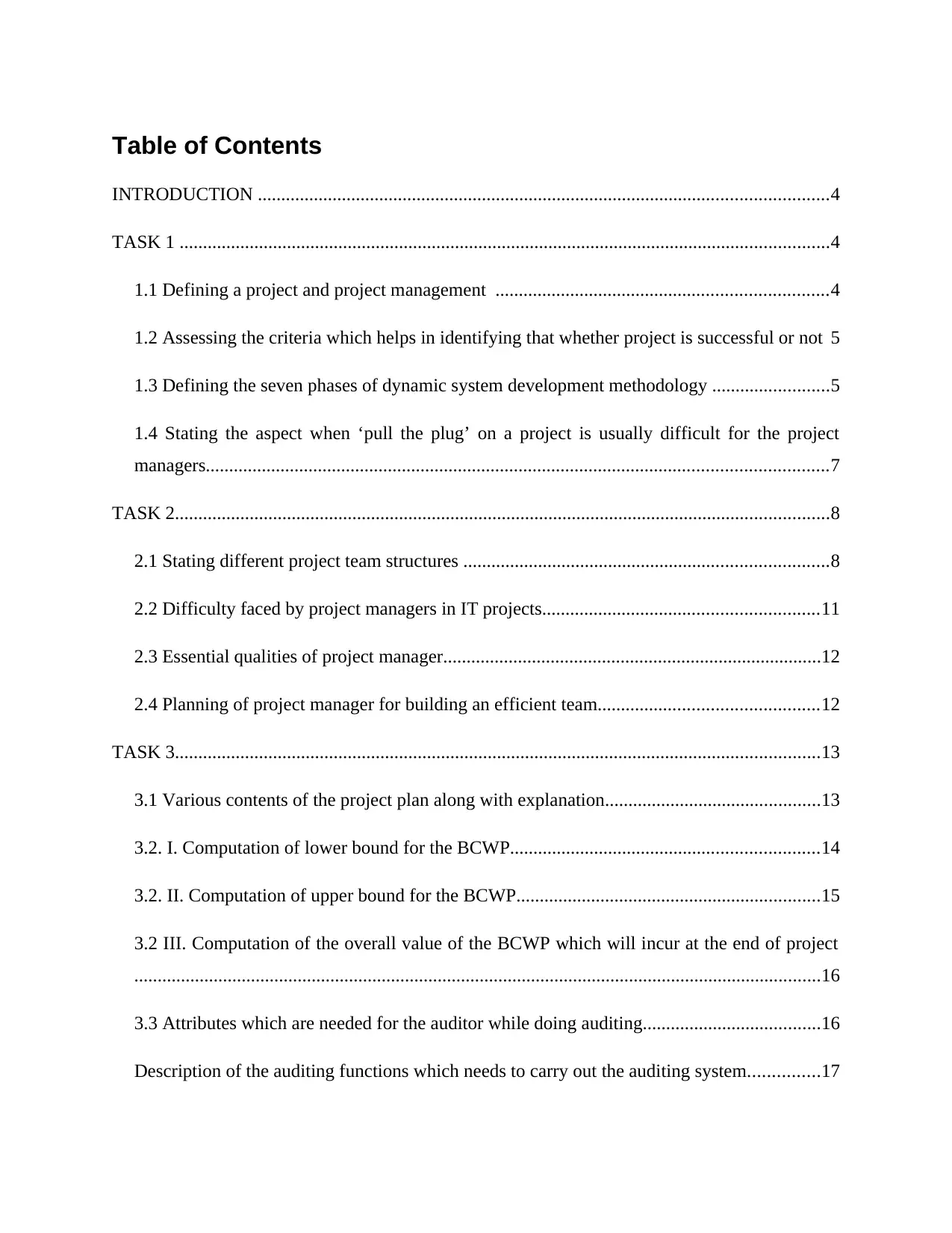
Table of Contents
INTRODUCTION ..........................................................................................................................4
TASK 1 ...........................................................................................................................................4
1.1 Defining a project and project management .......................................................................4
1.2 Assessing the criteria which helps in identifying that whether project is successful or not 5
1.3 Defining the seven phases of dynamic system development methodology .........................5
1.4 Stating the aspect when ‘pull the plug’ on a project is usually difficult for the project
managers.....................................................................................................................................7
TASK 2............................................................................................................................................8
2.1 Stating different project team structures ..............................................................................8
2.2 Difficulty faced by project managers in IT projects...........................................................11
2.3 Essential qualities of project manager.................................................................................12
2.4 Planning of project manager for building an efficient team...............................................12
TASK 3..........................................................................................................................................13
3.1 Various contents of the project plan along with explanation..............................................13
3.2. I. Computation of lower bound for the BCWP..................................................................14
3.2. II. Computation of upper bound for the BCWP.................................................................15
3.2 III. Computation of the overall value of the BCWP which will incur at the end of project
...................................................................................................................................................16
3.3 Attributes which are needed for the auditor while doing auditing......................................16
Description of the auditing functions which needs to carry out the auditing system...............17
INTRODUCTION ..........................................................................................................................4
TASK 1 ...........................................................................................................................................4
1.1 Defining a project and project management .......................................................................4
1.2 Assessing the criteria which helps in identifying that whether project is successful or not 5
1.3 Defining the seven phases of dynamic system development methodology .........................5
1.4 Stating the aspect when ‘pull the plug’ on a project is usually difficult for the project
managers.....................................................................................................................................7
TASK 2............................................................................................................................................8
2.1 Stating different project team structures ..............................................................................8
2.2 Difficulty faced by project managers in IT projects...........................................................11
2.3 Essential qualities of project manager.................................................................................12
2.4 Planning of project manager for building an efficient team...............................................12
TASK 3..........................................................................................................................................13
3.1 Various contents of the project plan along with explanation..............................................13
3.2. I. Computation of lower bound for the BCWP..................................................................14
3.2. II. Computation of upper bound for the BCWP.................................................................15
3.2 III. Computation of the overall value of the BCWP which will incur at the end of project
...................................................................................................................................................16
3.3 Attributes which are needed for the auditor while doing auditing......................................16
Description of the auditing functions which needs to carry out the auditing system...............17

3.4 Various kind of elements and aspects of the change control system..................................17
Conclusion.....................................................................................................................................18
REFERENCES .............................................................................................................................19
Conclusion.....................................................................................................................................18
REFERENCES .............................................................................................................................19
⊘ This is a preview!⊘
Do you want full access?
Subscribe today to unlock all pages.

Trusted by 1+ million students worldwide
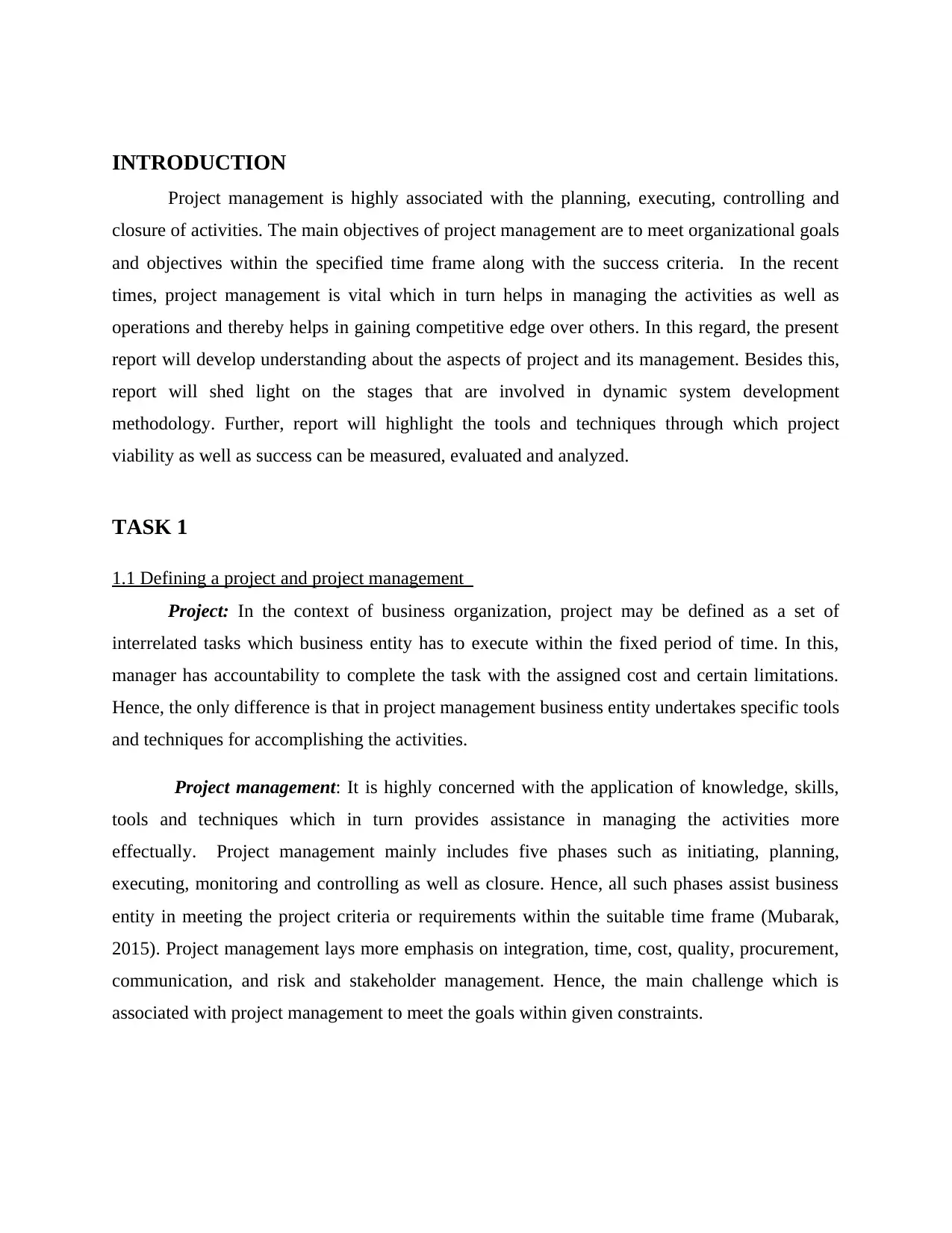
INTRODUCTION
Project management is highly associated with the planning, executing, controlling and
closure of activities. The main objectives of project management are to meet organizational goals
and objectives within the specified time frame along with the success criteria. In the recent
times, project management is vital which in turn helps in managing the activities as well as
operations and thereby helps in gaining competitive edge over others. In this regard, the present
report will develop understanding about the aspects of project and its management. Besides this,
report will shed light on the stages that are involved in dynamic system development
methodology. Further, report will highlight the tools and techniques through which project
viability as well as success can be measured, evaluated and analyzed.
TASK 1
1.1 Defining a project and project management
Project: In the context of business organization, project may be defined as a set of
interrelated tasks which business entity has to execute within the fixed period of time. In this,
manager has accountability to complete the task with the assigned cost and certain limitations.
Hence, the only difference is that in project management business entity undertakes specific tools
and techniques for accomplishing the activities.
Project management: It is highly concerned with the application of knowledge, skills,
tools and techniques which in turn provides assistance in managing the activities more
effectually. Project management mainly includes five phases such as initiating, planning,
executing, monitoring and controlling as well as closure. Hence, all such phases assist business
entity in meeting the project criteria or requirements within the suitable time frame (Mubarak,
2015). Project management lays more emphasis on integration, time, cost, quality, procurement,
communication, and risk and stakeholder management. Hence, the main challenge which is
associated with project management to meet the goals within given constraints.
Project management is highly associated with the planning, executing, controlling and
closure of activities. The main objectives of project management are to meet organizational goals
and objectives within the specified time frame along with the success criteria. In the recent
times, project management is vital which in turn helps in managing the activities as well as
operations and thereby helps in gaining competitive edge over others. In this regard, the present
report will develop understanding about the aspects of project and its management. Besides this,
report will shed light on the stages that are involved in dynamic system development
methodology. Further, report will highlight the tools and techniques through which project
viability as well as success can be measured, evaluated and analyzed.
TASK 1
1.1 Defining a project and project management
Project: In the context of business organization, project may be defined as a set of
interrelated tasks which business entity has to execute within the fixed period of time. In this,
manager has accountability to complete the task with the assigned cost and certain limitations.
Hence, the only difference is that in project management business entity undertakes specific tools
and techniques for accomplishing the activities.
Project management: It is highly concerned with the application of knowledge, skills,
tools and techniques which in turn provides assistance in managing the activities more
effectually. Project management mainly includes five phases such as initiating, planning,
executing, monitoring and controlling as well as closure. Hence, all such phases assist business
entity in meeting the project criteria or requirements within the suitable time frame (Mubarak,
2015). Project management lays more emphasis on integration, time, cost, quality, procurement,
communication, and risk and stakeholder management. Hence, the main challenge which is
associated with project management to meet the goals within given constraints.
Paraphrase This Document
Need a fresh take? Get an instant paraphrase of this document with our AI Paraphraser
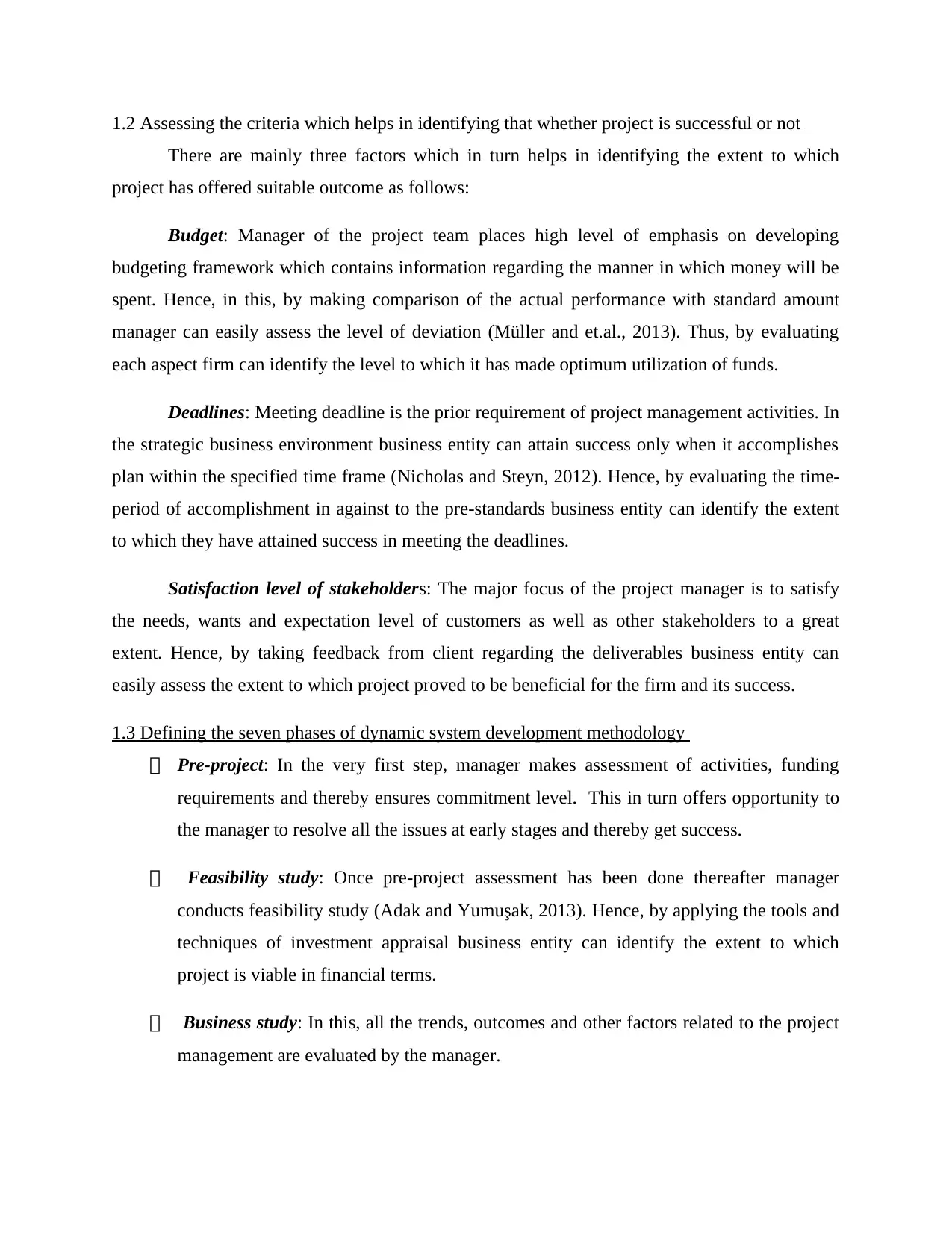
1.2 Assessing the criteria which helps in identifying that whether project is successful or not
There are mainly three factors which in turn helps in identifying the extent to which
project has offered suitable outcome as follows:
Budget: Manager of the project team places high level of emphasis on developing
budgeting framework which contains information regarding the manner in which money will be
spent. Hence, in this, by making comparison of the actual performance with standard amount
manager can easily assess the level of deviation (Müller and et.al., 2013). Thus, by evaluating
each aspect firm can identify the level to which it has made optimum utilization of funds.
Deadlines: Meeting deadline is the prior requirement of project management activities. In
the strategic business environment business entity can attain success only when it accomplishes
plan within the specified time frame (Nicholas and Steyn, 2012). Hence, by evaluating the time-
period of accomplishment in against to the pre-standards business entity can identify the extent
to which they have attained success in meeting the deadlines.
Satisfaction level of stakeholders: The major focus of the project manager is to satisfy
the needs, wants and expectation level of customers as well as other stakeholders to a great
extent. Hence, by taking feedback from client regarding the deliverables business entity can
easily assess the extent to which project proved to be beneficial for the firm and its success.
1.3 Defining the seven phases of dynamic system development methodology
Pre-project: In the very first step, manager makes assessment of activities, funding
requirements and thereby ensures commitment level. This in turn offers opportunity to
the manager to resolve all the issues at early stages and thereby get success.
Feasibility study: Once pre-project assessment has been done thereafter manager
conducts feasibility study (Adak and Yumuşak, 2013). Hence, by applying the tools and
techniques of investment appraisal business entity can identify the extent to which
project is viable in financial terms.
Business study: In this, all the trends, outcomes and other factors related to the project
management are evaluated by the manager.
There are mainly three factors which in turn helps in identifying the extent to which
project has offered suitable outcome as follows:
Budget: Manager of the project team places high level of emphasis on developing
budgeting framework which contains information regarding the manner in which money will be
spent. Hence, in this, by making comparison of the actual performance with standard amount
manager can easily assess the level of deviation (Müller and et.al., 2013). Thus, by evaluating
each aspect firm can identify the level to which it has made optimum utilization of funds.
Deadlines: Meeting deadline is the prior requirement of project management activities. In
the strategic business environment business entity can attain success only when it accomplishes
plan within the specified time frame (Nicholas and Steyn, 2012). Hence, by evaluating the time-
period of accomplishment in against to the pre-standards business entity can identify the extent
to which they have attained success in meeting the deadlines.
Satisfaction level of stakeholders: The major focus of the project manager is to satisfy
the needs, wants and expectation level of customers as well as other stakeholders to a great
extent. Hence, by taking feedback from client regarding the deliverables business entity can
easily assess the extent to which project proved to be beneficial for the firm and its success.
1.3 Defining the seven phases of dynamic system development methodology
Pre-project: In the very first step, manager makes assessment of activities, funding
requirements and thereby ensures commitment level. This in turn offers opportunity to
the manager to resolve all the issues at early stages and thereby get success.
Feasibility study: Once pre-project assessment has been done thereafter manager
conducts feasibility study (Adak and Yumuşak, 2013). Hence, by applying the tools and
techniques of investment appraisal business entity can identify the extent to which
project is viable in financial terms.
Business study: In this, all the trends, outcomes and other factors related to the project
management are evaluated by the manager.
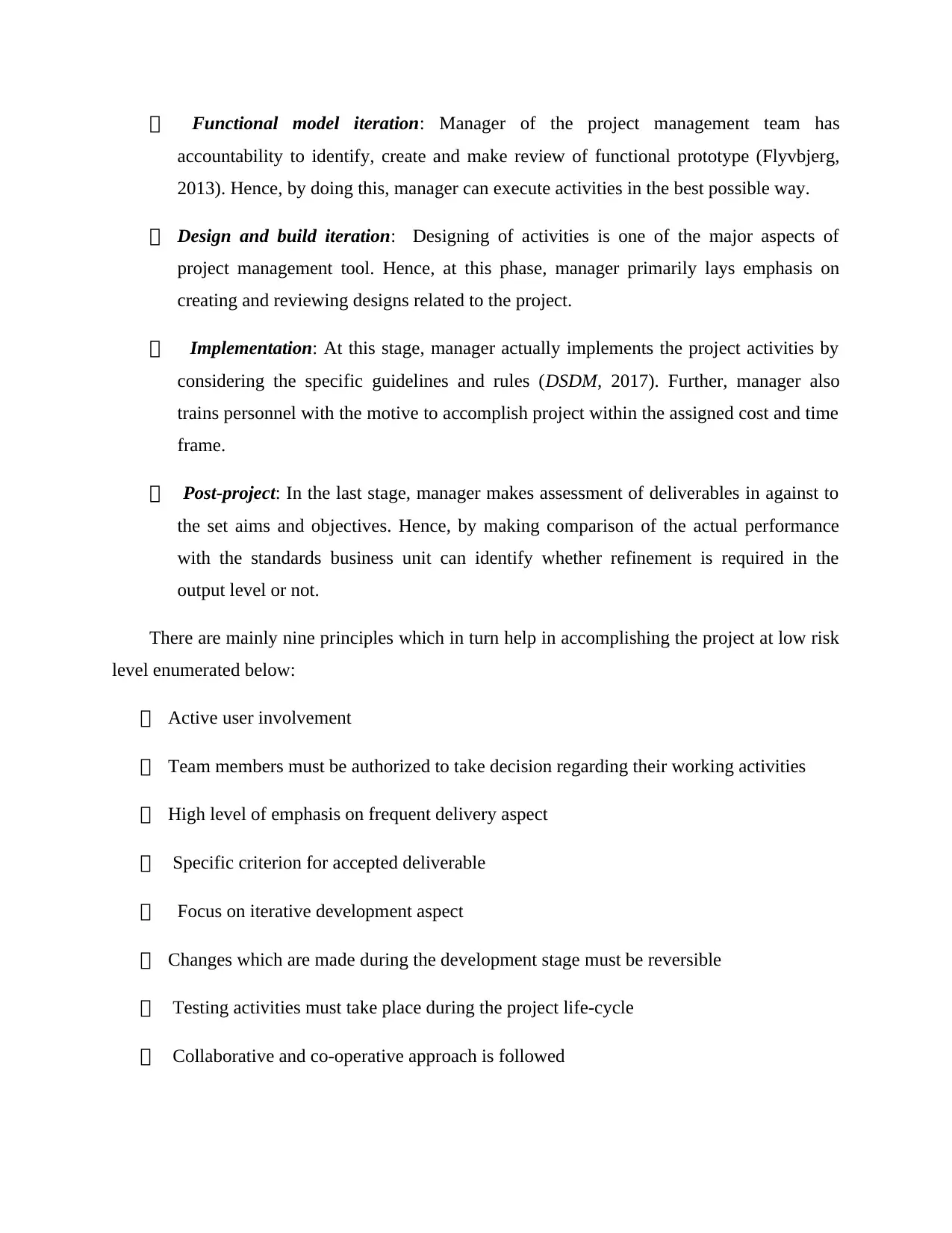
Functional model iteration: Manager of the project management team has
accountability to identify, create and make review of functional prototype (Flyvbjerg,
2013). Hence, by doing this, manager can execute activities in the best possible way.
Design and build iteration: Designing of activities is one of the major aspects of
project management tool. Hence, at this phase, manager primarily lays emphasis on
creating and reviewing designs related to the project.
Implementation: At this stage, manager actually implements the project activities by
considering the specific guidelines and rules (DSDM, 2017). Further, manager also
trains personnel with the motive to accomplish project within the assigned cost and time
frame.
Post-project: In the last stage, manager makes assessment of deliverables in against to
the set aims and objectives. Hence, by making comparison of the actual performance
with the standards business unit can identify whether refinement is required in the
output level or not.
There are mainly nine principles which in turn help in accomplishing the project at low risk
level enumerated below:
Active user involvement
Team members must be authorized to take decision regarding their working activities
High level of emphasis on frequent delivery aspect
Specific criterion for accepted deliverable
Focus on iterative development aspect
Changes which are made during the development stage must be reversible
Testing activities must take place during the project life-cycle
Collaborative and co-operative approach is followed
accountability to identify, create and make review of functional prototype (Flyvbjerg,
2013). Hence, by doing this, manager can execute activities in the best possible way.
Design and build iteration: Designing of activities is one of the major aspects of
project management tool. Hence, at this phase, manager primarily lays emphasis on
creating and reviewing designs related to the project.
Implementation: At this stage, manager actually implements the project activities by
considering the specific guidelines and rules (DSDM, 2017). Further, manager also
trains personnel with the motive to accomplish project within the assigned cost and time
frame.
Post-project: In the last stage, manager makes assessment of deliverables in against to
the set aims and objectives. Hence, by making comparison of the actual performance
with the standards business unit can identify whether refinement is required in the
output level or not.
There are mainly nine principles which in turn help in accomplishing the project at low risk
level enumerated below:
Active user involvement
Team members must be authorized to take decision regarding their working activities
High level of emphasis on frequent delivery aspect
Specific criterion for accepted deliverable
Focus on iterative development aspect
Changes which are made during the development stage must be reversible
Testing activities must take place during the project life-cycle
Collaborative and co-operative approach is followed
⊘ This is a preview!⊘
Do you want full access?
Subscribe today to unlock all pages.

Trusted by 1+ million students worldwide
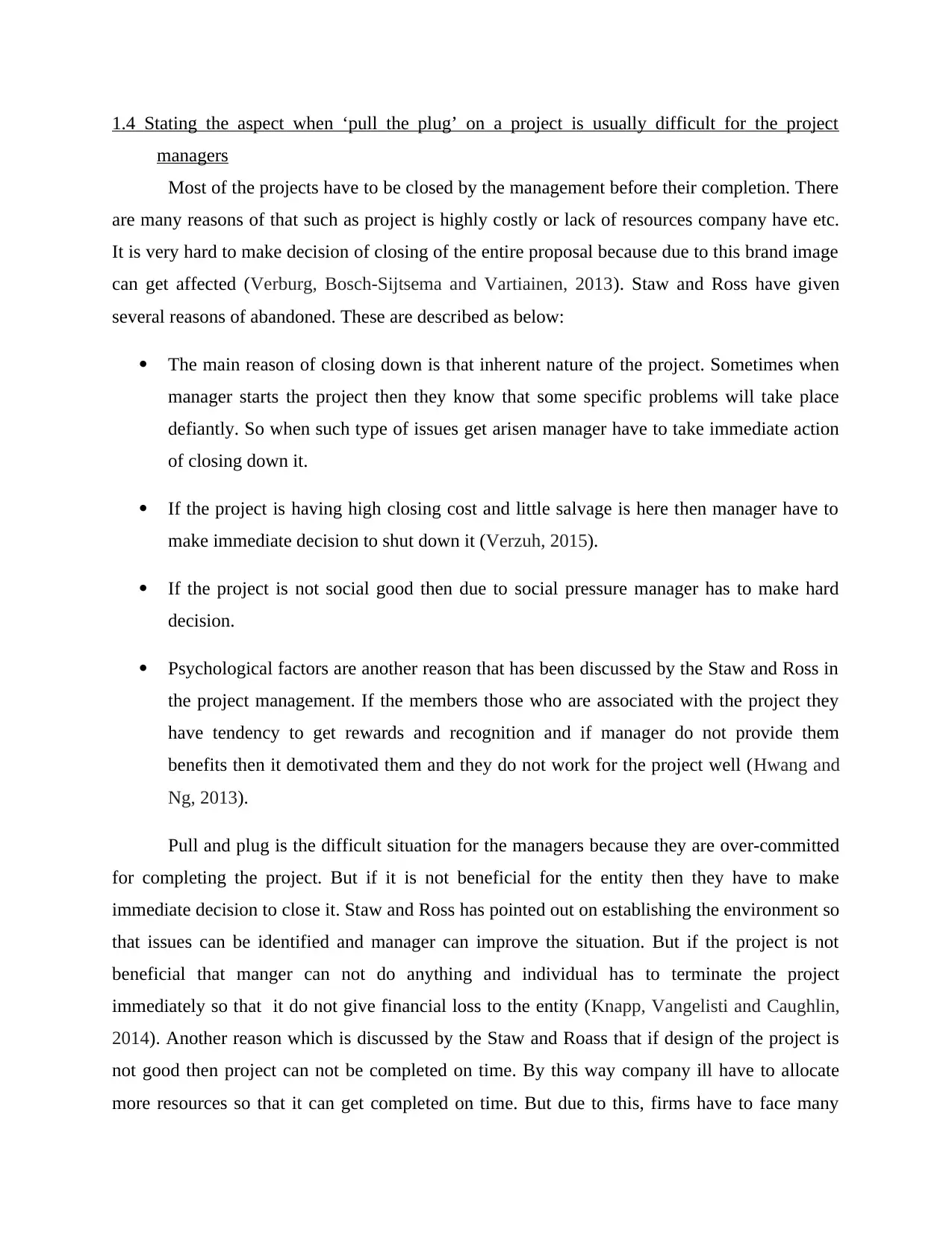
1.4 Stating the aspect when ‘pull the plug’ on a project is usually difficult for the project
managers
Most of the projects have to be closed by the management before their completion. There
are many reasons of that such as project is highly costly or lack of resources company have etc.
It is very hard to make decision of closing of the entire proposal because due to this brand image
can get affected (Verburg, Bosch-Sijtsema and Vartiainen, 2013). Staw and Ross have given
several reasons of abandoned. These are described as below:
The main reason of closing down is that inherent nature of the project. Sometimes when
manager starts the project then they know that some specific problems will take place
defiantly. So when such type of issues get arisen manager have to take immediate action
of closing down it.
If the project is having high closing cost and little salvage is here then manager have to
make immediate decision to shut down it (Verzuh, 2015).
If the project is not social good then due to social pressure manager has to make hard
decision.
Psychological factors are another reason that has been discussed by the Staw and Ross in
the project management. If the members those who are associated with the project they
have tendency to get rewards and recognition and if manager do not provide them
benefits then it demotivated them and they do not work for the project well (Hwang and
Ng, 2013).
Pull and plug is the difficult situation for the managers because they are over-committed
for completing the project. But if it is not beneficial for the entity then they have to make
immediate decision to close it. Staw and Ross has pointed out on establishing the environment so
that issues can be identified and manager can improve the situation. But if the project is not
beneficial that manger can not do anything and individual has to terminate the project
immediately so that it do not give financial loss to the entity (Knapp, Vangelisti and Caughlin,
2014). Another reason which is discussed by the Staw and Roass that if design of the project is
not good then project can not be completed on time. By this way company ill have to allocate
more resources so that it can get completed on time. But due to this, firms have to face many
managers
Most of the projects have to be closed by the management before their completion. There
are many reasons of that such as project is highly costly or lack of resources company have etc.
It is very hard to make decision of closing of the entire proposal because due to this brand image
can get affected (Verburg, Bosch-Sijtsema and Vartiainen, 2013). Staw and Ross have given
several reasons of abandoned. These are described as below:
The main reason of closing down is that inherent nature of the project. Sometimes when
manager starts the project then they know that some specific problems will take place
defiantly. So when such type of issues get arisen manager have to take immediate action
of closing down it.
If the project is having high closing cost and little salvage is here then manager have to
make immediate decision to shut down it (Verzuh, 2015).
If the project is not social good then due to social pressure manager has to make hard
decision.
Psychological factors are another reason that has been discussed by the Staw and Ross in
the project management. If the members those who are associated with the project they
have tendency to get rewards and recognition and if manager do not provide them
benefits then it demotivated them and they do not work for the project well (Hwang and
Ng, 2013).
Pull and plug is the difficult situation for the managers because they are over-committed
for completing the project. But if it is not beneficial for the entity then they have to make
immediate decision to close it. Staw and Ross has pointed out on establishing the environment so
that issues can be identified and manager can improve the situation. But if the project is not
beneficial that manger can not do anything and individual has to terminate the project
immediately so that it do not give financial loss to the entity (Knapp, Vangelisti and Caughlin,
2014). Another reason which is discussed by the Staw and Roass that if design of the project is
not good then project can not be completed on time. By this way company ill have to allocate
more resources so that it can get completed on time. But due to this, firms have to face many
Paraphrase This Document
Need a fresh take? Get an instant paraphrase of this document with our AI Paraphraser
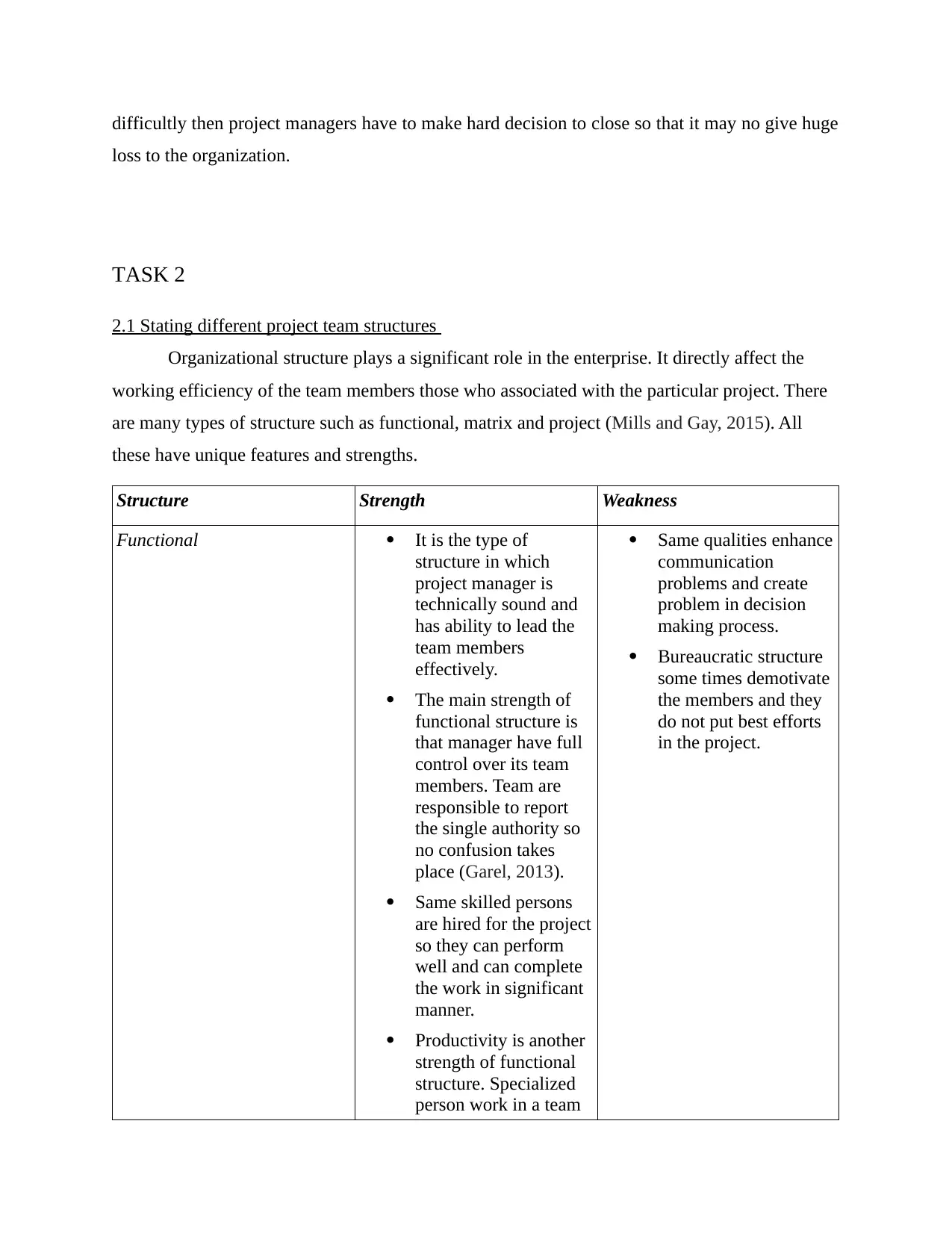
difficultly then project managers have to make hard decision to close so that it may no give huge
loss to the organization.
TASK 2
2.1 Stating different project team structures
Organizational structure plays a significant role in the enterprise. It directly affect the
working efficiency of the team members those who associated with the particular project. There
are many types of structure such as functional, matrix and project (Mills and Gay, 2015). All
these have unique features and strengths.
Structure Strength Weakness
Functional It is the type of
structure in which
project manager is
technically sound and
has ability to lead the
team members
effectively.
The main strength of
functional structure is
that manager have full
control over its team
members. Team are
responsible to report
the single authority so
no confusion takes
place (Garel, 2013).
Same skilled persons
are hired for the project
so they can perform
well and can complete
the work in significant
manner.
Productivity is another
strength of functional
structure. Specialized
person work in a team
Same qualities enhance
communication
problems and create
problem in decision
making process.
Bureaucratic structure
some times demotivate
the members and they
do not put best efforts
in the project.
loss to the organization.
TASK 2
2.1 Stating different project team structures
Organizational structure plays a significant role in the enterprise. It directly affect the
working efficiency of the team members those who associated with the particular project. There
are many types of structure such as functional, matrix and project (Mills and Gay, 2015). All
these have unique features and strengths.
Structure Strength Weakness
Functional It is the type of
structure in which
project manager is
technically sound and
has ability to lead the
team members
effectively.
The main strength of
functional structure is
that manager have full
control over its team
members. Team are
responsible to report
the single authority so
no confusion takes
place (Garel, 2013).
Same skilled persons
are hired for the project
so they can perform
well and can complete
the work in significant
manner.
Productivity is another
strength of functional
structure. Specialized
person work in a team
Same qualities enhance
communication
problems and create
problem in decision
making process.
Bureaucratic structure
some times demotivate
the members and they
do not put best efforts
in the project.
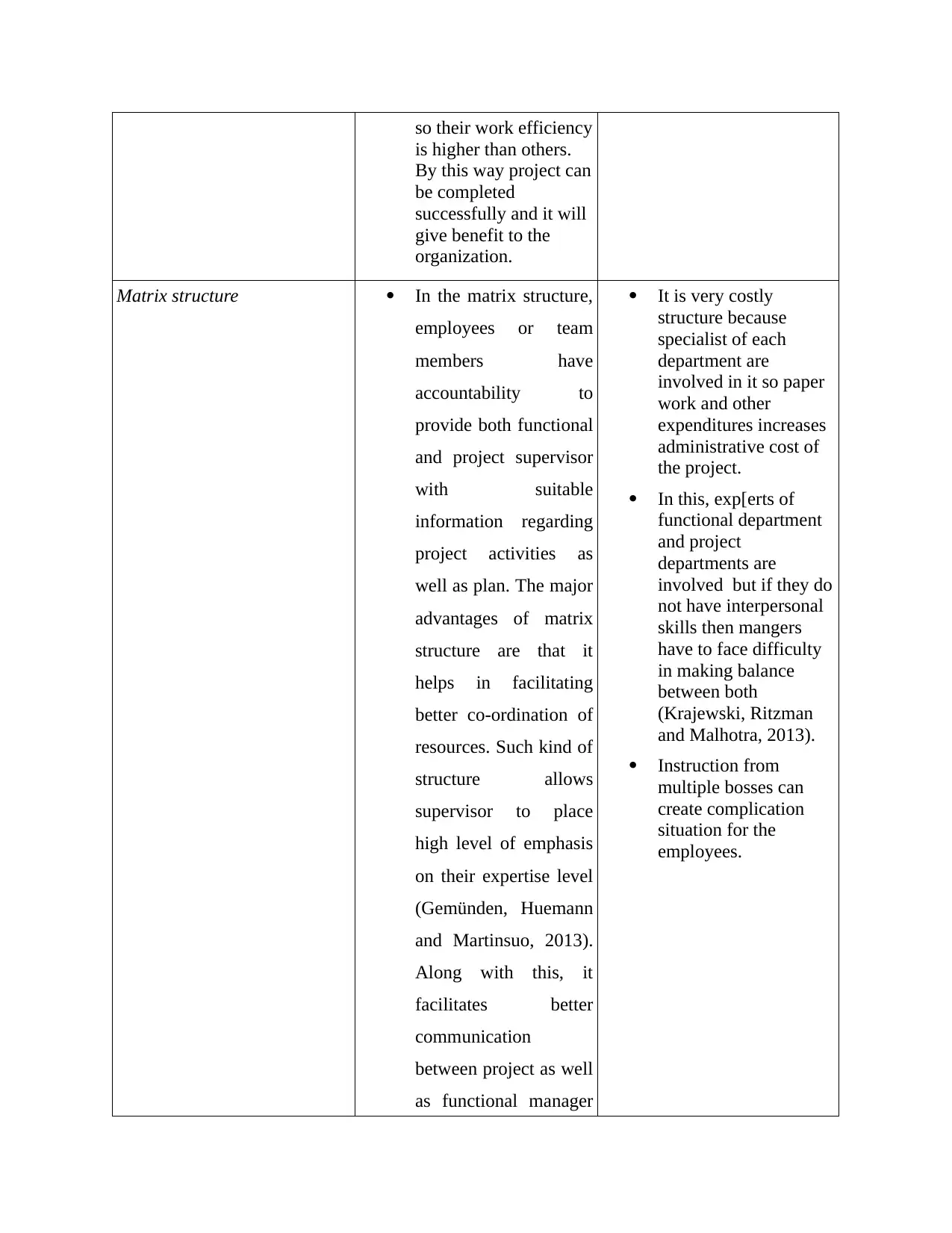
so their work efficiency
is higher than others.
By this way project can
be completed
successfully and it will
give benefit to the
organization.
Matrix structure In the matrix structure,
employees or team
members have
accountability to
provide both functional
and project supervisor
with suitable
information regarding
project activities as
well as plan. The major
advantages of matrix
structure are that it
helps in facilitating
better co-ordination of
resources. Such kind of
structure allows
supervisor to place
high level of emphasis
on their expertise level
(Gemünden, Huemann
and Martinsuo, 2013).
Along with this, it
facilitates better
communication
between project as well
as functional manager
It is very costly
structure because
specialist of each
department are
involved in it so paper
work and other
expenditures increases
administrative cost of
the project.
In this, exp[erts of
functional department
and project
departments are
involved but if they do
not have interpersonal
skills then mangers
have to face difficulty
in making balance
between both
(Krajewski, Ritzman
and Malhotra, 2013).
Instruction from
multiple bosses can
create complication
situation for the
employees.
is higher than others.
By this way project can
be completed
successfully and it will
give benefit to the
organization.
Matrix structure In the matrix structure,
employees or team
members have
accountability to
provide both functional
and project supervisor
with suitable
information regarding
project activities as
well as plan. The major
advantages of matrix
structure are that it
helps in facilitating
better co-ordination of
resources. Such kind of
structure allows
supervisor to place
high level of emphasis
on their expertise level
(Gemünden, Huemann
and Martinsuo, 2013).
Along with this, it
facilitates better
communication
between project as well
as functional manager
It is very costly
structure because
specialist of each
department are
involved in it so paper
work and other
expenditures increases
administrative cost of
the project.
In this, exp[erts of
functional department
and project
departments are
involved but if they do
not have interpersonal
skills then mangers
have to face difficulty
in making balance
between both
(Krajewski, Ritzman
and Malhotra, 2013).
Instruction from
multiple bosses can
create complication
situation for the
employees.
⊘ This is a preview!⊘
Do you want full access?
Subscribe today to unlock all pages.

Trusted by 1+ million students worldwide
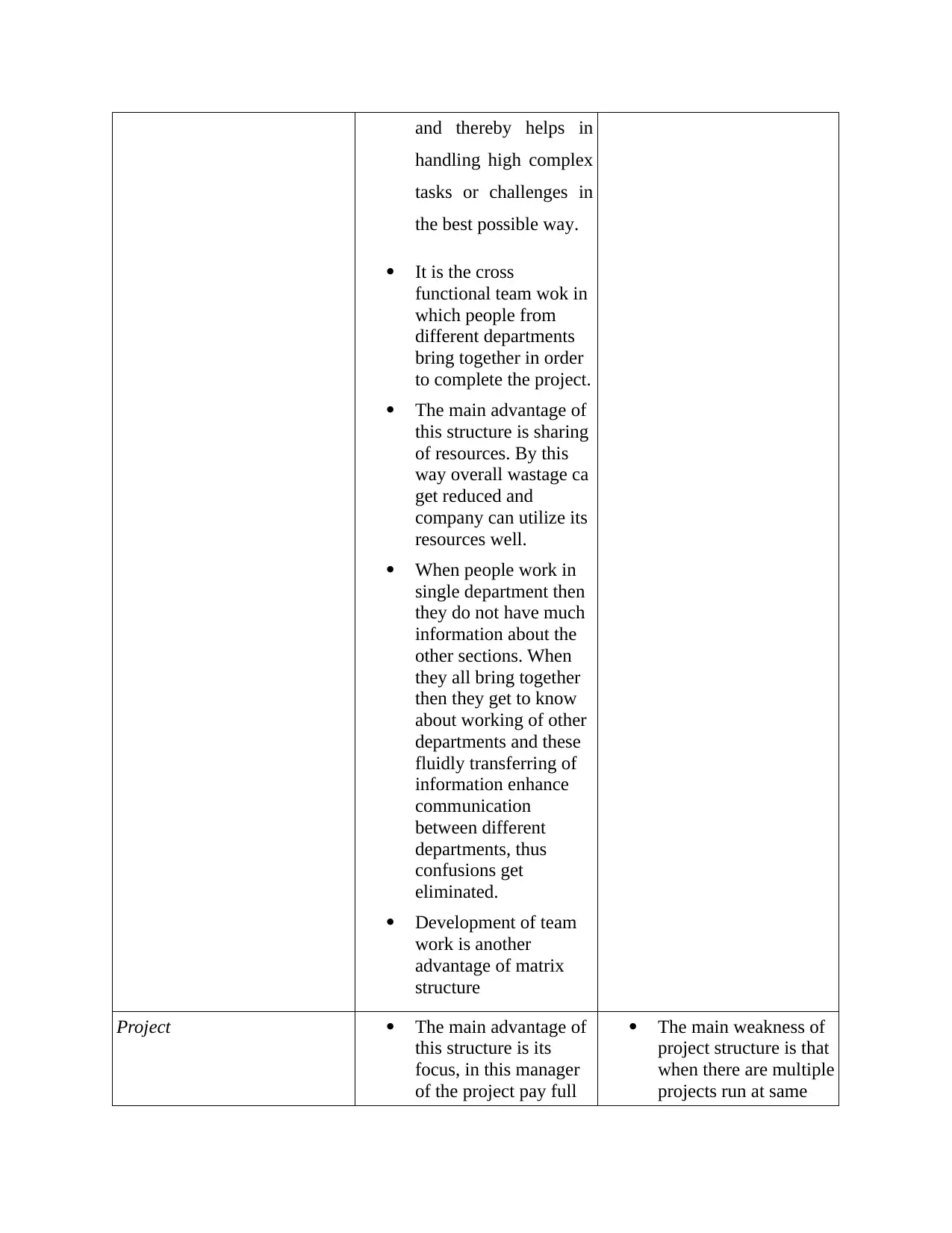
and thereby helps in
handling high complex
tasks or challenges in
the best possible way.
It is the cross
functional team wok in
which people from
different departments
bring together in order
to complete the project.
The main advantage of
this structure is sharing
of resources. By this
way overall wastage ca
get reduced and
company can utilize its
resources well.
When people work in
single department then
they do not have much
information about the
other sections. When
they all bring together
then they get to know
about working of other
departments and these
fluidly transferring of
information enhance
communication
between different
departments, thus
confusions get
eliminated.
Development of team
work is another
advantage of matrix
structure
Project The main advantage of
this structure is its
focus, in this manager
of the project pay full
The main weakness of
project structure is that
when there are multiple
projects run at same
handling high complex
tasks or challenges in
the best possible way.
It is the cross
functional team wok in
which people from
different departments
bring together in order
to complete the project.
The main advantage of
this structure is sharing
of resources. By this
way overall wastage ca
get reduced and
company can utilize its
resources well.
When people work in
single department then
they do not have much
information about the
other sections. When
they all bring together
then they get to know
about working of other
departments and these
fluidly transferring of
information enhance
communication
between different
departments, thus
confusions get
eliminated.
Development of team
work is another
advantage of matrix
structure
Project The main advantage of
this structure is its
focus, in this manager
of the project pay full
The main weakness of
project structure is that
when there are multiple
projects run at same
Paraphrase This Document
Need a fresh take? Get an instant paraphrase of this document with our AI Paraphraser
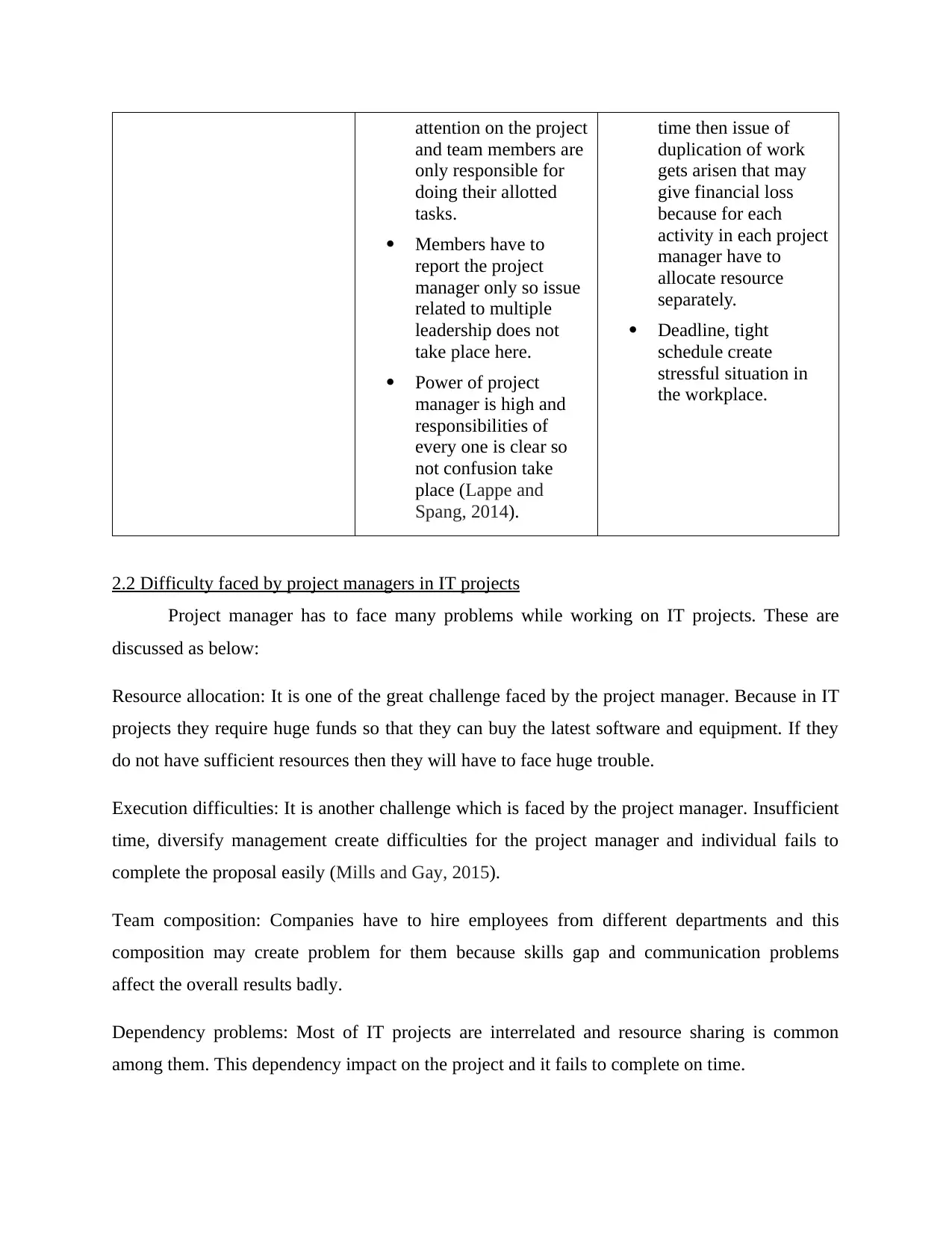
attention on the project
and team members are
only responsible for
doing their allotted
tasks.
Members have to
report the project
manager only so issue
related to multiple
leadership does not
take place here.
Power of project
manager is high and
responsibilities of
every one is clear so
not confusion take
place (Lappe and
Spang, 2014).
time then issue of
duplication of work
gets arisen that may
give financial loss
because for each
activity in each project
manager have to
allocate resource
separately.
Deadline, tight
schedule create
stressful situation in
the workplace.
2.2 Difficulty faced by project managers in IT projects
Project manager has to face many problems while working on IT projects. These are
discussed as below:
Resource allocation: It is one of the great challenge faced by the project manager. Because in IT
projects they require huge funds so that they can buy the latest software and equipment. If they
do not have sufficient resources then they will have to face huge trouble.
Execution difficulties: It is another challenge which is faced by the project manager. Insufficient
time, diversify management create difficulties for the project manager and individual fails to
complete the proposal easily (Mills and Gay, 2015).
Team composition: Companies have to hire employees from different departments and this
composition may create problem for them because skills gap and communication problems
affect the overall results badly.
Dependency problems: Most of IT projects are interrelated and resource sharing is common
among them. This dependency impact on the project and it fails to complete on time.
and team members are
only responsible for
doing their allotted
tasks.
Members have to
report the project
manager only so issue
related to multiple
leadership does not
take place here.
Power of project
manager is high and
responsibilities of
every one is clear so
not confusion take
place (Lappe and
Spang, 2014).
time then issue of
duplication of work
gets arisen that may
give financial loss
because for each
activity in each project
manager have to
allocate resource
separately.
Deadline, tight
schedule create
stressful situation in
the workplace.
2.2 Difficulty faced by project managers in IT projects
Project manager has to face many problems while working on IT projects. These are
discussed as below:
Resource allocation: It is one of the great challenge faced by the project manager. Because in IT
projects they require huge funds so that they can buy the latest software and equipment. If they
do not have sufficient resources then they will have to face huge trouble.
Execution difficulties: It is another challenge which is faced by the project manager. Insufficient
time, diversify management create difficulties for the project manager and individual fails to
complete the proposal easily (Mills and Gay, 2015).
Team composition: Companies have to hire employees from different departments and this
composition may create problem for them because skills gap and communication problems
affect the overall results badly.
Dependency problems: Most of IT projects are interrelated and resource sharing is common
among them. This dependency impact on the project and it fails to complete on time.
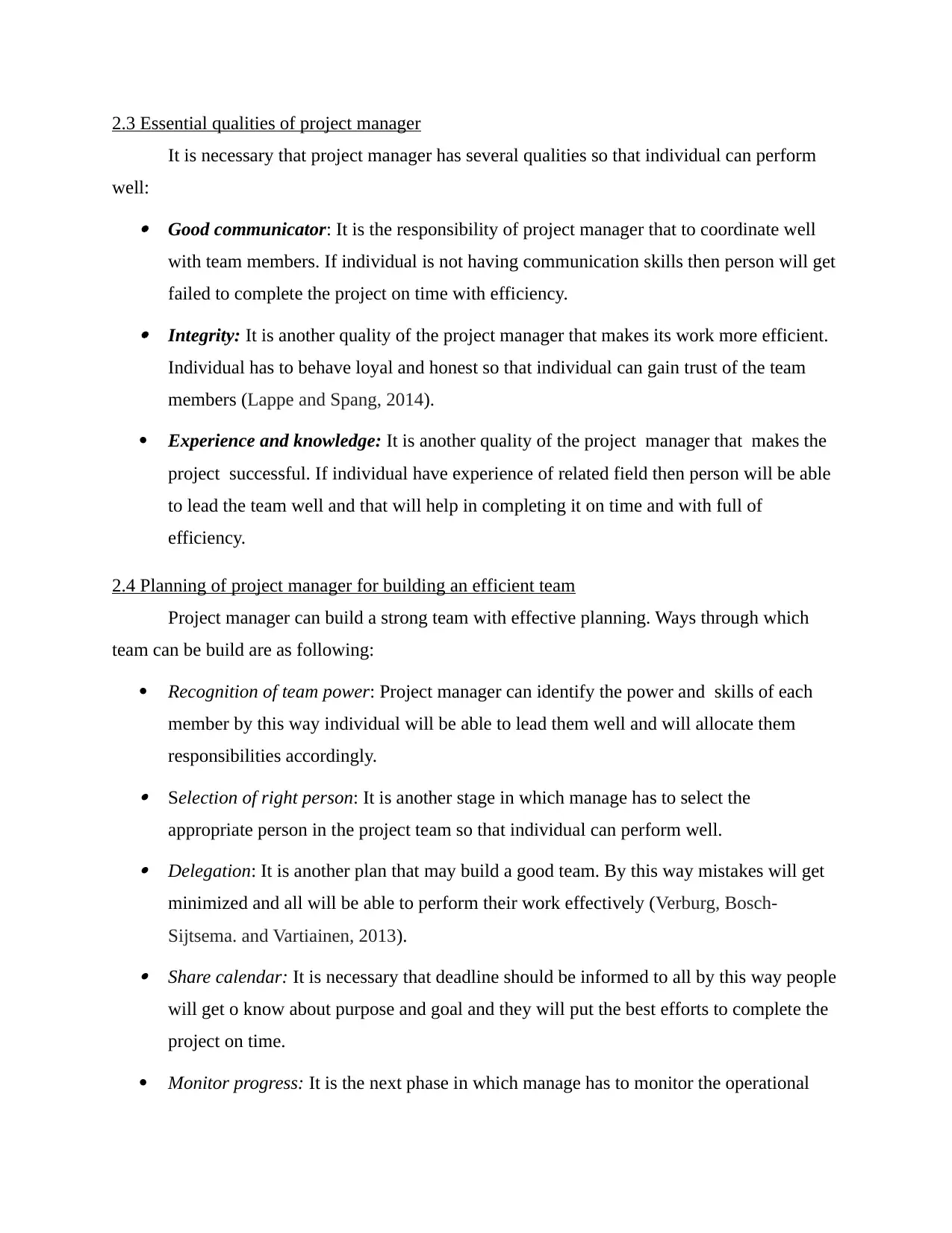
2.3 Essential qualities of project manager
It is necessary that project manager has several qualities so that individual can perform
well: Good communicator: It is the responsibility of project manager that to coordinate well
with team members. If individual is not having communication skills then person will get
failed to complete the project on time with efficiency. Integrity: It is another quality of the project manager that makes its work more efficient.
Individual has to behave loyal and honest so that individual can gain trust of the team
members (Lappe and Spang, 2014).
Experience and knowledge: It is another quality of the project manager that makes the
project successful. If individual have experience of related field then person will be able
to lead the team well and that will help in completing it on time and with full of
efficiency.
2.4 Planning of project manager for building an efficient team
Project manager can build a strong team with effective planning. Ways through which
team can be build are as following:
Recognition of team power: Project manager can identify the power and skills of each
member by this way individual will be able to lead them well and will allocate them
responsibilities accordingly. Selection of right person: It is another stage in which manage has to select the
appropriate person in the project team so that individual can perform well. Delegation: It is another plan that may build a good team. By this way mistakes will get
minimized and all will be able to perform their work effectively (Verburg, Bosch-
Sijtsema. and Vartiainen, 2013). Share calendar: It is necessary that deadline should be informed to all by this way people
will get o know about purpose and goal and they will put the best efforts to complete the
project on time.
Monitor progress: It is the next phase in which manage has to monitor the operational
It is necessary that project manager has several qualities so that individual can perform
well: Good communicator: It is the responsibility of project manager that to coordinate well
with team members. If individual is not having communication skills then person will get
failed to complete the project on time with efficiency. Integrity: It is another quality of the project manager that makes its work more efficient.
Individual has to behave loyal and honest so that individual can gain trust of the team
members (Lappe and Spang, 2014).
Experience and knowledge: It is another quality of the project manager that makes the
project successful. If individual have experience of related field then person will be able
to lead the team well and that will help in completing it on time and with full of
efficiency.
2.4 Planning of project manager for building an efficient team
Project manager can build a strong team with effective planning. Ways through which
team can be build are as following:
Recognition of team power: Project manager can identify the power and skills of each
member by this way individual will be able to lead them well and will allocate them
responsibilities accordingly. Selection of right person: It is another stage in which manage has to select the
appropriate person in the project team so that individual can perform well. Delegation: It is another plan that may build a good team. By this way mistakes will get
minimized and all will be able to perform their work effectively (Verburg, Bosch-
Sijtsema. and Vartiainen, 2013). Share calendar: It is necessary that deadline should be informed to all by this way people
will get o know about purpose and goal and they will put the best efforts to complete the
project on time.
Monitor progress: It is the next phase in which manage has to monitor the operational
⊘ This is a preview!⊘
Do you want full access?
Subscribe today to unlock all pages.

Trusted by 1+ million students worldwide
1 out of 20
Related Documents
Your All-in-One AI-Powered Toolkit for Academic Success.
+13062052269
info@desklib.com
Available 24*7 on WhatsApp / Email
![[object Object]](/_next/static/media/star-bottom.7253800d.svg)
Unlock your academic potential
Copyright © 2020–2025 A2Z Services. All Rights Reserved. Developed and managed by ZUCOL.





